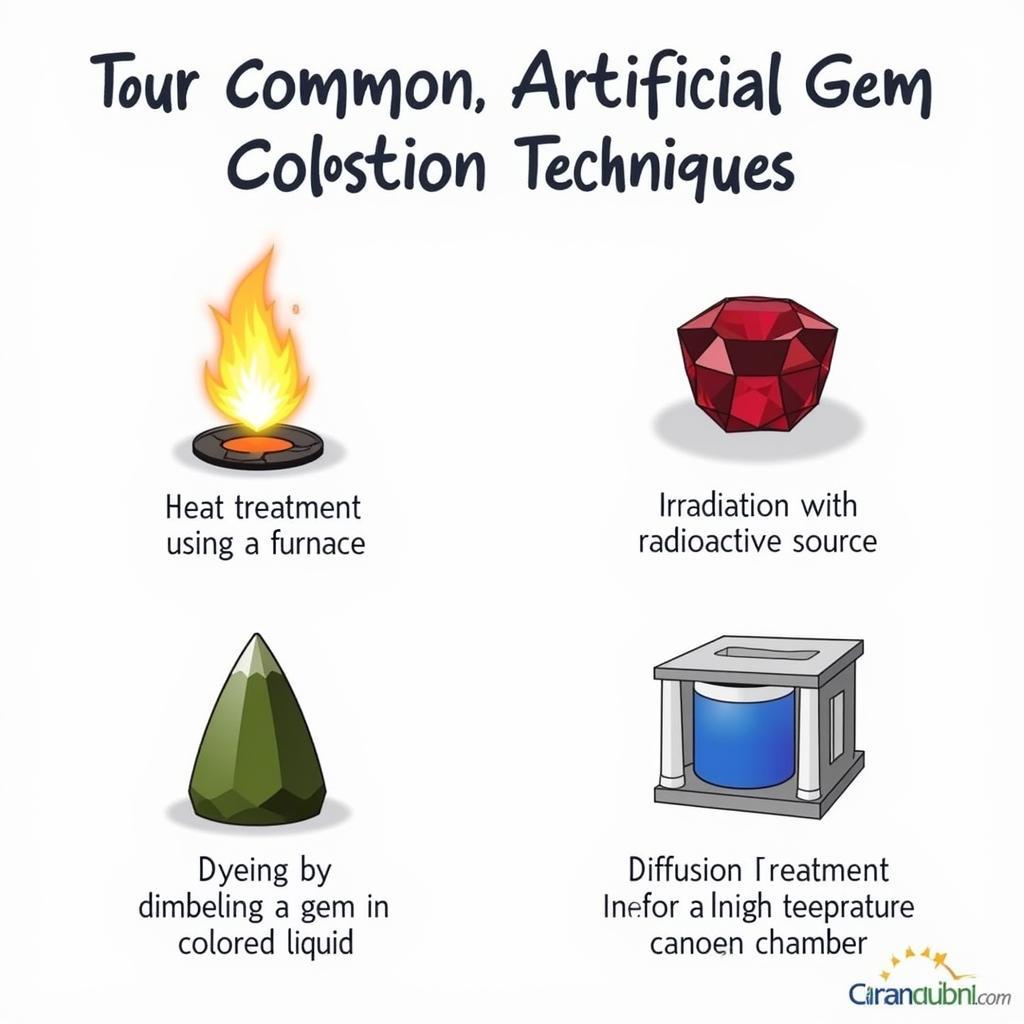Coloring gemstones is a fascinating process that combines art and science. Whether you’re an aspiring jewelry designer, a curious crafter, or simply intrigued by the vibrant hues of gemstones, understanding how to color gems opens a world of creative possibilities. This article delves into the intricacies of gem coloration, exploring both natural and artificial methods, and offering valuable insights into achieving stunning results.
Understanding Gem Color
Gem color originates from a complex interplay of light absorption and reflection. Trace elements within the gem’s crystal structure interact with light, selectively absorbing certain wavelengths and transmitting others. This selective absorption creates the vibrant colors we admire. For instance, chromium gives rubies their characteristic red, while iron imparts the green hue to emeralds. Understanding these basic principles is crucial for anyone interested in how to color gems. What color are natural pearls? Often, they exhibit a subtle creamy white or soft pinkish hue due to their organic origin. After this introduction, let’s explore the fascinating world of gem coloration. what color are natural pearls offers further insight into their natural coloring.
Natural Gem Coloration
Natural gem coloration occurs over geological timescales, influenced by factors like the presence of trace elements, temperature, and pressure during crystal formation. Amethyst, for instance, gets its purple color from iron impurities and natural irradiation. The rarity and intensity of certain natural colors contribute significantly to a gem’s value.
Factors Influencing Natural Color
- Trace Elements: Minute quantities of elements like chromium, iron, manganese, and titanium can dramatically alter a gem’s color.
- Crystal Structure: The arrangement of atoms within the crystal lattice affects how light interacts with the gem, influencing its color.
- Geological Conditions: Temperature, pressure, and the surrounding environment during gem formation all play a role in the final color.
Artificial Gem Coloration
While natural gem colors are prized, artificial coloration techniques allow for enhancing or altering a gem’s appearance. These techniques can range from heat treatment to irradiation and dyeing. Knowing the color of onyx can help determine if it has been treated. what color is onyx provides details on its natural color variations.
Common Artificial Coloration Techniques
- Heat Treatment: Applying heat can intensify or change a gem’s color by altering the oxidation state of trace elements.
- Irradiation: Exposing gems to radiation can create or enhance color centers within the crystal structure.
- Dyeing: Porous gems can be dyed to impart vibrant colors, though this method is generally less permanent than other techniques.
- Diffusion Treatment: Introducing coloring agents into the gem’s surface layer at high temperatures can create a thin layer of color.
 Gem Coloration Techniques: Heat Treatment, Irradiation, Dyeing, and Diffusion
Gem Coloration Techniques: Heat Treatment, Irradiation, Dyeing, and Diffusion
Choosing the Right Coloration Method
The best method for how to color gems depends on the type of gem, the desired color, and the intended use. For instance, heat treatment is often used to enhance the blue color of sapphires, while dyeing is more common for porous gems like turquoise. Jade’s color can be naturally enhanced or artificially altered. To understand jade’s natural color spectrum, what color is jade is a valuable resource.
Considerations for Coloration
- Gem Type: Different gems respond differently to various coloration techniques.
- Desired Color: The desired color outcome will influence the choice of method.
- Durability: Some coloration techniques are more permanent than others.
- Cost: The cost of coloration can vary significantly depending on the method and the gem.
Conclusion
Knowing how to color gems effectively requires a deep understanding of gemmology, chemistry, and artistry. Whether embracing the natural beauty of untreated gems or exploring the possibilities of artificial enhancement, the world of gem coloration offers a rich tapestry of color and creativity. By carefully considering the various factors and techniques discussed in this article, you can embark on a journey of transforming ordinary stones into breathtaking works of art. The color of gemstones can be fascinating. Have you ever wondered what color gemstone is associated with June? You can find out more here: what color gemstone is june.
FAQ
- Is artificial gem coloration ethical? Yes, as long as it is disclosed to the buyer.
- How can I tell if a gem has been treated? Gemological testing can reveal evidence of treatments.
- Does coloration affect a gem’s value? It can, depending on the type of treatment and the gem.
- Are treated gems less durable? Not necessarily, but some treatments can affect durability.
- Can I color gems at home? Some simple treatments, like dyeing, can be done at home, but others require specialized equipment.
- What is the most common gem coloration method? Heat treatment is the most widely used method.
- How long do artificial gem colors last? Most permanent treatments last indefinitely.
Situations and Questions
-
Situation: You inherited a gemstone but are unsure of its origin or treatment.
-
Question: How can I get my gemstone appraised and identified?
-
Situation: You want to enhance the color of a gemstone you own.
-
Question: What coloration method is best suited for my specific gem type?
Further Exploration
- Learn more about the science behind gemstone colors.
- Explore the history and cultural significance of various gemstones.
- Discover the fascinating world of what color are goldfish.
Need assistance with gem coloration or other color-related queries? Contact us at 0373298888, email us at [email protected], or visit our showroom at 86 Cầu Giấy, Hanoi. Our 24/7 customer service team is ready to assist you.
